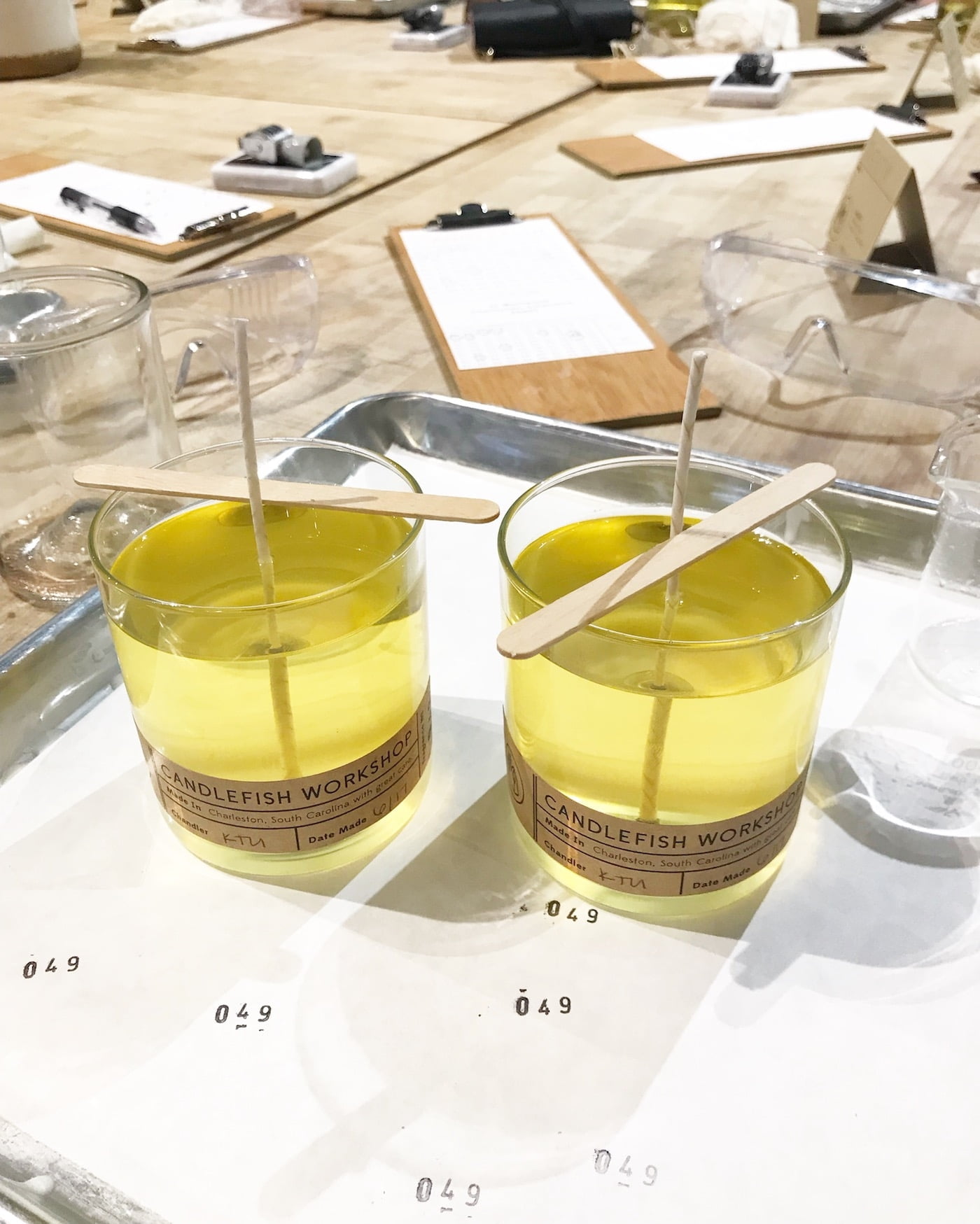Candle making has gained immense popularity as a hobby and even as a small business venture in recent years. As more people embrace the craft, it is crucial to ensure safety throughout the process. In this article, we will specifically focus on the safety concerns surrounding bergamot fragrance oil in candle making.
Fragrance oils are an integral part of creating scented candles that fill our homes with delightful aromas. However, not all fragrance oils are safe for use, and bergamot fragrance oil is one such example. While bergamot offers a refreshing and citrusy scent, there are potential risks associated with its use in candle making.
Understanding these hazards is essential for anyone who wants to indulge in candle making or wishes to incorporate bergamot fragrance oil into their creations. In the following sections, we will delve deeper into what exactly bergamot is and why it’s commonly used in candle making. We will also explore the potential health effects and sensitization issues linked to its usage and offer alternative recommendations for safer options.
By educating ourselves about the risks associated with using bergamot fragrance oil and taking necessary precautions, we can continue enjoying our candle-making endeavors while ensuring our safety and that of those around us. Let’s dive into the world of candle making with fragrance oils to gain a better understanding of where caution should be exercised when considering bergamot as an option.
What is Bergamot and its Common Use in Candle Making
Bergamot is a citrus fruit that is mainly cultivated in Italy. It has a distinct aroma that is often described as refreshing and uplifting, making it a popular choice for candle making. The essential oil extracted from bergamot is commonly used in perfumes, cosmetics, and aromatherapy due to its therapeutic properties.
In candle making, bergamot fragrance oil is widely used to create candles with a citrusy scent. The oil adds a unique and vibrant note to the final product, creating an inviting ambiance in any space.
The process of extracting bergamot essential oil involves pressing the rinds of the fruit to release the fragrant oil. This method ensures that the oil retains its aromatic properties while removing any potentially harmful substances.
Although bergamot fragrance oil is widely used in candle making and other industries, it’s important to be aware of the safety concerns associated with it. Bergamot contains chemical constituents such as bergapten and bergamottin, which can cause skin irritation and increase sensitivity to sunlight when applied directly on the skin undiluted.
To mitigate these risks, it’s crucial to use bergamot fragrance oil in moderation and properly dilute it before incorporating it into candle making projects. This can be achieved by following recommended usage guidelines provided by reputable fragrance oil suppliers or conducting patch tests to ensure skin compatibility.
Using alternative fragrance oils that mimic the aroma of bergamot is another option for those who want to avoid potential hazards associated with pure bergamot fragrance oil. There are various safe and non-toxic alternatives available in the market that offer similar scents without the same risks, allowing candle makers to create their desired citrusy candles without compromising safety.
When working with bergamot fragrance oil or any other type of fragrance oil in candle making, proper handling and safety precautions should always be followed. Personal protective equipment such as gloves and goggles should be worn to protect against direct contact with the oil. Adequate ventilation in the workspace is also crucial to prevent the accumulation of fumes. Proper storage of bergamot fragrance oil is essential to maintain its quality and prevent any potential accidents.
Understanding the Safety Concerns Associated with Bergamot Fragrance Oil
Bergamot fragrance oil is known for its distinct and refreshing scent, making it a popular choice among candle makers. However, it is essential to understand the safety concerns associated with using bergamot fragrance oil in candle making. This section will provide an overview of the potential risks and hazards that come with using bergamot in candle making, highlight key chemical constituents that may pose safety risks, and discuss the importance of moderation and proper dilution when using bergamot fragrance oil.
When working with bergamot fragrance oil, it is crucial to be aware of potential health effects and sensitization issues. Bergamot contains chemical compounds such as bergapten and citropten, which can increase the skin’s sensitivity to sunlight and may potentially cause phototoxicity.
This means that exposure to sunlight or other sources of ultraviolet light after applying bergamot fragrance oil onto the skin can lead to severe burns or rashes. It is essential to note that even after the candles are made, burning them can also release these compounds into the air, potentially causing respiratory issues for sensitive individuals.
To minimize risks associated with using bergamot fragrance oil, it is advisable to conduct patch tests on individuals prone to sensitization before incorporating this fragrance into candles. A patch test involves applying a small amount of diluted bergamot fragrance oil on a small patch of skin and monitoring for any adverse reactions over a 24-hour period.
Additionally, proper dilution is crucial when using bergamot fragrance oil in candle making. It is recommended to follow industry guidelines on maximum usage rates for fragrances to ensure safe levels.
While bergamot fragrance oil can have safety concerns, there are alternative recommendations available for candle makers who desire a similar aroma without the associated risks. There are non-toxic fragrance oils on the market that mimic the scent of bergamot while not containing the same chemical constituents known for their potential hazards. These alternatives provide candle makers with a safer option for achieving the desired fragrance in their creations.
By understanding and acknowledging the safety concerns associated with using bergamot fragrance oil, candle makers can take the necessary precautions to ensure a safe and enjoyable experience. It is important to research and educate yourselves on potential risks, consult reputable suppliers, and conduct quality control measures when working with bergamot fragrance oil. By balancing creativity with safety precautions, candle makers can continue to enjoy the beauty and aroma of bergamot in their creations while minimizing potential hazards.
Potential Health Effects and Sensitization Issues of Bergamot Fragrance Oil
Potential Skin Irritation and Phototoxicity Risks
Bergamot fragrance oil has the potential to cause skin irritation and phototoxicity when used in candle making. This is primarily due to the presence of chemical compounds such as bergapten and bergamottin, which are known photosensitizers. When applied to the skin and exposed to sunlight or other ultraviolet (UV) rays, these compounds can cause a reaction that results in redness, inflammation, and even blistering.
To minimize the risk of skin irritation, it is essential to use bergamot fragrance oil in moderation and with proper dilution. It is recommended to follow guidelines provided by reputable suppliers regarding safe usage levels for specific products. Additionally, conducting patch tests on a small area of skin before applying a product containing bergamot fragrance oil can help identify any potential sensitivity or allergic reactions.
Respiratory Effects of Inhaling Bergamot Fragrance Oil
While the primary concern for using bergamot fragrance oil in candle making lies in its potential for skin irritation, there are also respiratory considerations to be aware of. When candles scented with bergamot fragrance oil are burned, they release volatile organic compounds (VOCs) into the air. Inhaling these VOCs over time may irritate the respiratory system and potentially trigger respiratory issues such as allergies or asthma.
To mitigate the respiratory effects of bergamot fragrance oil, it is important to ensure proper ventilation when burning scented candles. This can involve keeping windows open or using air purifiers to circulate fresh air. Furthermore, choosing high-quality candles made with non-toxic waxes and lead-free wicks can also contribute to a healthier indoor environment.
Safety Precautions for Working with Bergamot Fragrance Oil
When working with bergamot fragrance oil in candle making, it is crucial to prioritize safety and take certain precautions. Here are some recommended measures to minimize the associated risks:
- Personal Protective Equipment (PPE): Wear gloves and goggles while handling bergamot fragrance oil to prevent direct contact with the skin and eyes.
- Proper Ventilation: Ensure that the workspace is well-ventilated by opening windows or using fans to minimize exposure to VOCs released during the burning process.
- Storage: Store bergamot fragrance oil in a cool, dark place away from direct sunlight and heat sources to maintain its quality and reduce the risk of chemical degradation.
- Labeling: Clearly label containers that contain bergamot fragrance oil to avoid confusion or accidental misuse.
By following these safety precautions, candle makers can enjoy their creative pursuits while minimizing the potential health effects associated with bergamot fragrance oil.
Alternative Recommendations for Bergamot-Like Fragrances in Candle Making
For those who want to replicate the distinct aroma of bergamot but are concerned about its potential safety risks, there are alternative fragrance oils available that provide a similar scent without the same hazards. These alternatives offer candle makers the opportunity to create beautiful and fragrant candles while ensuring the safety of themselves and their customers.
- Grapefruit Essential Oil: Grapefruit essential oil has a bright and citrusy scent that closely resembles bergamot. It is obtained from the peel of grapefruits through a process called cold-pressing. This method preserves the natural aromatic compounds found in grapefruits, making it an excellent option for achieving a bergamot-like fragrance in candles.
- Lemon Essential Oil: Lemon essential oil offers a refreshing and zesty aroma that is reminiscent of bergamot. It is derived from the rinds of lemons using steam distillation. Lemon essential oil is known for its uplifting properties and can add a vibrant scent to your candles.
- Sweet Orange Essential Oil: Sweet orange essential oil is another great alternative for capturing the citrusy notes found in bergamot. Extracted from orange peels, this oil has a warm and inviting fragrance that can enhance your candle-making creations.
When using these alternative fragrance oils, it’s crucial to choose high-quality oils from reputable suppliers to ensure both safety and fragrance accuracy. Additionally, be sure to follow proper dilution guidelines recommended by the supplier to achieve the desired scent without overpowering or risking any potential adverse reactions.
By considering these alternatives, candle makers can expand their selection of fragrances while minimizing any potential safety concerns associated with using pure bergamot essential oil or fragrance oils derived from it.
Proper Handling and Safety Precautions for Using Bergamot Fragrance Oil in Candle Making
When it comes to using bergamot fragrance oil in candle making, it is crucial to prioritize safety and take the necessary precautions. Bergamot essential oil contains chemical constituents that may pose certain risks if not handled properly. This section will provide a detailed guide on the safety measures and handling precautions required for using bergamot fragrance oil in candle making.
Use Personal Protective Equipment (PPE)
To minimize the potential risks associated with bergamot fragrance oil, it is recommended to use personal protective equipment (PPE) during the candle-making process. Gloves should be worn to protect the skin from direct contact with the fragrance oil. Additionally, safety goggles can shield the eyes from any accidental splashes or droplets during handling or mixing.
Ensure Proper Ventilation
Proper ventilation is crucial when working with any fragrance oils, including bergamot fragrance oil, as they can release volatile organic compounds (VOCs) into the air. Adequate ventilation ensures that these harmful fumes are dispersed efficiently, reducing the risk of respiratory issues and irritations. It is advisable to work near an open window or in a well-ventilated area.
Store Bergamot Fragrance Oil Safely
Storing bergamot fragrance oil correctly is important for ensuring its longevity and minimizing potential hazards. It should be stored in a cool, dry place away from direct sunlight and heat sources. The container should be tightly sealed to prevent evaporation or spillage. Moreover, it is essential to keep bergamot fragrance oil out of reach of children and pets.
It is worth noting that these handling and safety precautions are not limited to bergamot fragrance oil alone but apply to all types of fragrance oils used in candle making. By following these guidelines, candle makers can minimize the risks and enjoy the process of incorporating bergamot fragrance oil into their creations safely.
The Importance of Research and Quality Control in Candle Making with Bergamot Fragrance Oil
When it comes to candle making with bergamot fragrance oil, conducting thorough research and implementing stringent quality control measures are essential for ensuring both safety and success. The popularity of candle making as a hobby or small business venture has surged in recent years, prompting individuals to explore different fragrance options such as bergamot. However, it is crucial to educate oneself on the potential hazards associated with using bergamot fragrance oil and take necessary precautions to minimize risks.
Research plays a pivotal role in candle making with bergamot fragrance oil. It is essential to understand the chemical composition of bergamot essential oil and its specific characteristics before incorporating it into candle making projects. This knowledge allows individuals to make informed decisions regarding proper dilution rates, usage guidelines, and potential safety measures. Seeking reputable sources that provide up-to-date information on the use of bergamot in candle making can prevent accidents, skin sensitization issues, or respiratory health complications.
Quality control measures are equally important when working with bergamot fragrance oil in candle making. Selecting a reliable supplier who offers high-quality oils is critical for ensuring product consistency and safety.
Reputable suppliers often adhere to rigorous manufacturing standards and can provide detailed information about the origin, extraction methods, and purity of their bergamot fragrance oil. Conducting quality control tests such as burn tests, scent throw evaluations, and monitoring batch consistency will help maintain an optimal level of quality for the finished candles.
| Potential Risks | Impact |
|---|---|
| Skin Irritation | Bergapten, a constituent of bergamot essential oil, may cause skin irritation or sensitization when used undiluted or in high concentrations. |
| Phototoxicity | Bergamot essential oil contains bergaptene, which can react with sunlight and cause severe burns or skin discoloration. It is crucial to avoid direct sunlight after applying bergamot fragrance oil topically. |
| Respiratory Effects | Inhaling the volatile compounds of bergamot fragrance oil during the burning process may trigger respiratory issues in individuals with underlying respiratory conditions. |
By incorporating research and quality control measures into your candle making process, you can maximize safety and enjoyment while working with bergamot fragrance oil. Remember to always prioritize safety by using personal protective equipment like gloves and goggles, ensuring proper ventilation in your workspace, and storing fragrance oils appropriately. With diligence and informed decision-making, you can navigate the potential risks associated with bergamot fragrance oil while crafting beautiful and aromatic candles.
Conclusion
In conclusion, when it comes to candle making with bergamot fragrance oil, it is crucial to make informed decisions for both safety and enjoyment. While bergamot offers a distinctive aroma that is often desired in candle making, it does come with potential hazards and safety concerns. Understanding and mitigating these risks is essential for a successful and safe candle making experience.
One key takeaway from this discussion is the importance of balance. It is important for candle makers to balance their creativity and desire for specific fragrances with the necessary safety precautions. This includes using bergamot fragrance oil in moderation and proper dilution, as well as conducting patch tests for individuals prone to sensitization.
Furthermore, it is vital to weigh the risks and benefits before incorporating bergamot fragrance oil into candle making pursuits. If the potential health effects or sensitization issues pose a significant concern, there are alternative fragrance oils available that mimic the aroma of bergamot without the same risks. Exploring these safe and non-toxic options can ensure a more enjoyable and worry-free candle making experience.
Frequently Asked Questions
Is bergamot safe to use?
Bergamot is generally considered safe to use, but it should be used with caution due to its potential side effects. It has a reputation for causing photosensitivity, which means it can make the skin more vulnerable to sunburn or skin damage when exposed to sunlight or UV rays.
Therefore, it is advisable to avoid applying bergamot oil topically before going out in the sun or using tanning beds. Additionally, bergamot oil can cause skin irritation in some individuals, so a patch test is recommended before using it extensively.
What does bergamot do in candles?
When used in candles, bergamot essential oil provides a pleasant and refreshing fragrance that is often described as citrusy and slightly floral. The aroma of bergamot can create a fresh and uplifting atmosphere when the candle is lit, making it an increasingly popular choice amongst candle makers.
Beyond its scent, some people believe that diffusing bergamot oil through candles may have mood-boosting properties or help reduce stress and anxiety. However, the effects of aromatherapy are subjective and can vary from person to person.
What essential oils are safe in candles?
There are several essential oils that are generally considered safe for use in candles. Some commonly used essential oils include lavender, chamomile, eucalyptus, peppermint, lemon, vanilla, and rosemary.
These oils not only provide delightful scents but also potentially offer therapeutic benefits like relaxation, stress relief, or mental clarity when released into the air through candle burning. However, it’s important to note that individual sensitivities and allergies may vary, so conducting appropriate research or seeking advice from professionals is recommended before using any specific essential oil in candles.

Welcome to my candle making blog! In this blog, I will be sharing my tips and tricks for making candles. I will also be sharing some of my favorite recipes.





